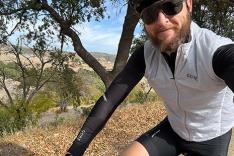Isolated Leg Training (ILT) Indoors
Many cyclists do ILT work in the winter and on an indoor trainer. The workout helps reduce or eliminate any dead spots out of your pedal stroke. One common workout example is to do a warm-up, then with light resistance on an indoor trainer, do 100 percent of the work with one leg while the other leg is resting on a stool.
The bottom of the stroke is similar to the motion of scraping mud off the bottom of your shoe. The top of the stroke can be improved by driving your toes and knees forward. In all positions, keep your toes relaxed. Do not allow them to curl up and clinch the bottom of your shoe. The aim is to be smooth and keep power applied during as much of each revolution as possible.
Begin with 20 or 30 seconds per leg and build up to 60 seconds per leg. After doing one set with each leg, spin with both legs for some 2 to 4 minutes before starting the ILT work again.
Start with a cumulative time of 3 to 5 minutes on each leg within the workout and build time as you become stronger. Be sure to stop pedaling and change legs or spin with both legs when your form becomes sloppy or jerky. Do not worry about achieving any particular heart rate--smooth pedaling form is most important.
Once you're efficiently making smooth circles on the trainer in a normal setup, you can put blocks under your front wheel to simulate hill climbing. Build the time you are able to complete ILT drills on hills.
More: The Truth About Indoor Cycling Cadence
ILT Work Outdoors
After achieving good form doing ILT work on an indoor trainer, move outdoors to a flat course. One method of doing ILT work outdoors is by relaxing and unweighting one leg while the other leg does 90 percent of the work. (The unweighted leg stays clipped in.)
A second method is to pull the non-working leg out of the pedal and allow it to hang about 6 to 12 inches away from the bike. In either case, use a gear combination that allows you to keep force on the pedal for the majority of the pedal stroke.
Be sure to change legs when fatigue sets in, or set a specific time interval to prevent excess fatigue. Again, correct form is most important. Similar to doing the drill indoors, work your way up to an interval of 30 to 60 seconds per leg. After doing a work segment with each leg, spin easy with both legs for a minute or two and then return to single leg work.
Finally, when you've achieved what you consider to be a good skill level at ILT work on a flat course, try the drill on a slight uphill. Of course it is most challenging when the non-working leg is removed from the pedal.
Why Do ILT Work on Hills?
At least one study1 concluded that cycling uphill decreases gross efficiency and is associated with changes in pedaling technique. If you train your legs to be as efficient as possible going uphill, of course it only helps your cause of increasing speed.
By practicing good pedaling technique and making a conscious effort to keep power to the pedals, I'm willing to bet your overall cycling speed will begin to increase. With foundation skills nailed, you can begin adjusting volume and intensity to make even more gains.
In no time you'll be one of those people gliding along at higher speeds, with less effort.
More: 3 Cycling Workouts to Help You Conquer Hills
 Ready to ride? Search for a cycling event.
Ready to ride? Search for a cycling event.1. Arkesteijn, M., et al, "The Effect of Gradient on Cycling Gross Efficiency and Technique," Medicine and Science in Sports and Exercise, 2012, Dec 14 (Epub ahead of print)
- 2
- of
- 2
About the Author

Gale Bernhardt was the USA Triathlon team coach at the 2003 Pan American Games and 2004 Athens Olympics. She's worked as one of the few World Cup coaches and delivered coached education training for the Triathlon Union's Sport Development Team. She has coached Olympic road racers, World Cup mountain bike riders and Leadville 100 racers. Thousands of athletes have had successful training and racing experiences using Gale's ready-to-use, easy-to-follow training plans.








Discuss This Article